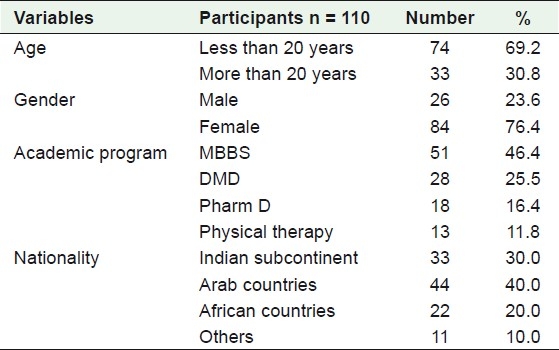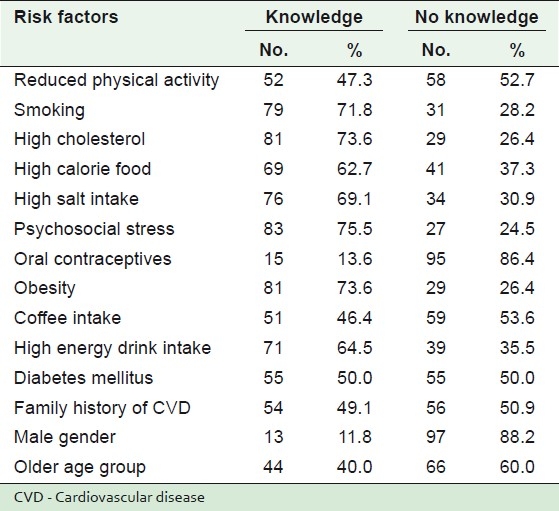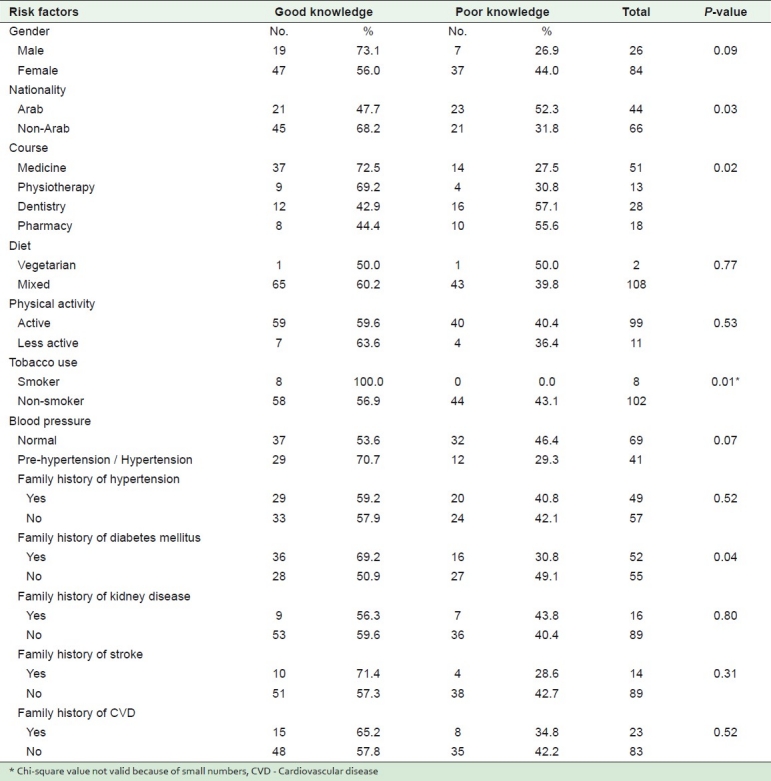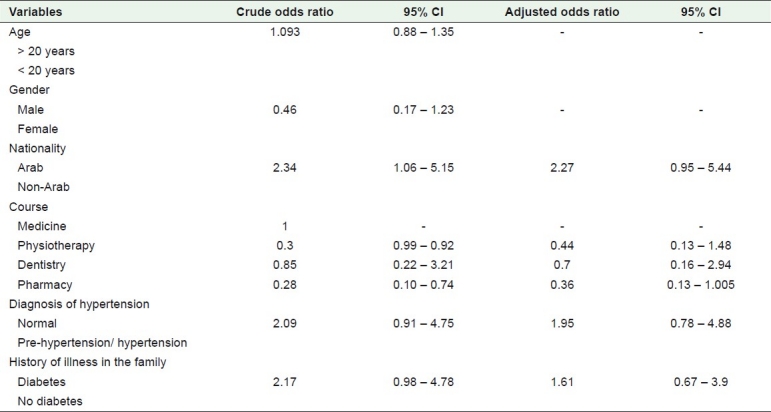Abstract
Context:
Hypertension in youth is increasing, but there is a dearth of data about the knowledge of risk factors in this age group.
Aims:
To assess the knowledge of risk factors of hypertension among university students and associate it with the blood pressure, physical activity, family history of cardiovascular disease (CVD), and sociodemographic variables.
Materials and Methods:
A cross-sectional survey among students enrolled in the first year, in the four academic programs, with the use of a validated, self-administered questionnaire on physical activity in the past 30 days and knowledge of risk factors of hypertension. A score of 6 on 11 was considered as good knowledge for modifiable risk factors. Blood pressure was also measured. The data was analyzed using PASW-17, Chi square test, and binary logistic regression analysis was done.
Results:
Of the 110 participants, 69.2% were < 20 years of age, 76.4% were females, and 40% were Arabs. Stress, high cholesterol, obesity, and smoking were identified as risk factors by 75.5, 73.6, 77.6, and 71.8%, respectively; 69.1% considered high salt intake and 62.7% considered high calorie diet as risk factors. Energy drink was considered as a risk factor by 64.5%, coffee consumption 35.5%, physical inactivity 47%, and oral contraceptives 13.6%. Half the group did not consider a family history of CVD as a risk factor, 60% did not consider older age as a risk factor, and 88% did not think male gender was a risk factor. Knowledge of modifiable risk factors was better than that of non-modifiable risk factors. Although nationality, course of study, raised blood pressure, and history of diabetes showed significant association with good knowledge, their net effect was not significant by the Adjusted Odd's Ratio.
Conclusions:
The study identified some gaps in knowledge regarding both modifiable and non-modifiable risk factors of hypertension among students. A larger study would enable health promotion activities tailored to the needs of this age group.
Keywords: Hypertension, knowledge, risk factors, university students
INTRODUCTION
Hypertension is a major contributor to the global disease burden.[1] It poses an important public health challenge to both economically developing and developed countries, including Asia.[2,3] The prevalence and rate of diagnosis of hypertension in children and adolescents appears to be increasing.[4]
Hypertension confers the highest attributable risk to deaths from cardiovascular disease[5] and epidemiological data provide convincing evidence that the risk of cardiovascular disease related to blood pressure is graded and continuous.[6] This risk is evident even in childhood; with elevated blood pressure predicting hypertension in adulthood,[7] and adverse effects of elevated blood pressure in childhood on vascular structure and function, specifically left ventricular hypertrophy, are already apparent in youth.[8–10] Reduction of blood pressure reduces this risk in people with and without hypertension and is a desired goal in children and adults.[11,12]
Even as most studies describe knowledge of hypertension and its risk factors in older adults and the elderly,[13] there is a paucity of such data among teenagers and young adults, as they are considered to be at a lower risk of developing the disease. With a growing problem of hypertension worldwide, there is a concern that hypertension in young adults may also be on the rise and that cases are not detected because of inadequate screening in this age group.[14]
The epidemiology of demographic transition states that a long-term shift occurs in mortality and disease patterns, whereby infectious diseases are gradually displaced by degenerative and man-made diseases as the chief form of morbidity and death.[15] Furthermore, evidence shows that UAE is a country in transition where people have adopted western living patterns; risk factors such as sedentary lifestyle;[16,17] obesity, stress, unhealthy diets;[18,19] and smoking[20–22] have all been demonstrated in young adults. The country also has an increased prevalence of hypertension 19–25%.[23]
Knowledge of the predisposing risk factors is vital in the modification of lifestyle behaviors conducive to optimal cardiovascular health.[24,25] Measuring and appropriately disseminating knowledge of the modifiable risk factors at an early age is an essential preventive educational approach. Strategies to achieve even a modest lowering of the levels of blood pressure in the population of children and young adults are therefore important public health goals. An attempt is made in the present study to assess the knowledge of risk factors of hypertension among university students and associate it with the blood pressure, physical activity, family history of CVD, and sociodemographic variables.
MATERIALS AND METHODS
Gulf Medical University Ajman, United Arab Emirates (UAE) has four colleges, namely, College of Medicine, College of Dentistry, College of Allied Health Sciences and College of Pharmacy, with multinational students. For the academic year 2009 – 2010 it had an annual intake of 160 students (60 in MBBS, 40 in DMD, 35 in Pharm D, and 25 in BPT), in the four programs, out of which 110 students who were present on the day of data collection participated in the study with a response rate of 68.75%.
The study was approved by the Ethics Committee of the Gulf Medical University. The survey was conducted using a pre-tested, structured, self-administered questionnaire. The questionnaire included sociodemographic variables like age, gender, nationality, ethnicity, and religion, and questions on the knowledge regarding the modifiable and non-modifiable risk factors for hypertension and a 30-day recall of physical activity. The students were categorized as less active if they did not practice any planned regular physical activity for at least 30 minutes / day for five days a week. To assess the knowledge on risk factors of hypertension, eleven modifiable and three non-modifiable risk factors were included. Each modifiable risk factor was given a score of one if it was answered correctly and zero for a wrong answer. Out of a total score of eleven a score of six and more was considered as good knowledge and a score less than six considered poor knowledge. This was validated by three experts in the area of public health, epidemiology, and internal medicine.
The investigators explained to the respective class the purpose of the study and sought verbal consent before distributing the questionnaires. Anyone was permitted to opt out of the study, however, all present in the classroom participated. When collecting back, the researchers checked and ensured the completeness of the questionnaires.
Blood pressure was measured by the same team using a mercury sphygmomanometer, twice, with a gap of one minute, and interpreted as per the blood pressure guidelines issued in 2003, by the National Heart, Lung, and Blood Institute as shown in Table 1.[26]
Table 1.
Blood pressure guidelines, 2003

Data was analyzed using PASW-17 (IBM, Chicago, Illinois). Chi Square test was done for association between knowledge of risk factors and age, gender, nationality, course, diet, physical activity, smoking, presence of hypertension, and family history of diabetes, hypertension, kidney disease, stroke, and CVD. In addition to the variables that showed a significant P-value (P < 0.05), gender (P value 0.09) and presence of pre / hypertension (P value 0.07) were included in the binary logistic regression analysis, to identify the Crude Odds Ratio (OR). Those factors with crude OR > 1 were included in the multiple binary logistic regression analysis, to calculate the Adjusted Odds Ratio.
RESULTS
The study assessed the knowledge of eleven modifiable and three non-modifiable risk factors of hypertension and its association with study variables in 110 entry level students in one medical university. The response rate was 68.75%.
Table 2 shows the sociodemographic profile of the study participants. Majority [74(69.2%)] of the participants was less than 20 years of age, 84 (76.4%) were females, 51 (46.4%) were in the MBBS course, and 44 (40%) were Arabs.
Table 2.
Sociodemographic characteristics of the participants

Of the 110 participants, stress, high cholesterol, obesity, and smoking were identified as risk factors by 83 (75.5%), 81 (73.6%), 81 (73.6%), and 79 (71.8%), respectively. Seventy-six (69.1%), considered high salt intake as a risk factor for hypertension, and 69 (62.7%) a high-calorie diet. Energy drink and coffee consumption were considered as risk factors by 71 (64.5%) and 51 (46.4%), respectively. Nearly half, 52 (47%) of the respondents were aware of physical inactivity being a risk factor, whereas, only 15 (13.6%) had knowledge of the risk of oral contraceptives in hypertension. The overall knowledge of modifiable risk factors was better than that of non-modifiable risk factors, wherein 97 (88%) did not know the risk related to male gender, 66 (60%) the risk with increasing age, and 56 (50%) the risk of family history of cardiovascular diseases [Table 3].
Table 3.
Knowledge regarding risk factors of hypertension among the participants

Table 4 shows the association between the knowledge of risk factors with different demographic and other variables. Overall 66 (60%) of the 110 participants had good knowledge of the modifiable risk factors. Significantly higher proportion of Non-Arabs had ‘good knowledge’ when compared to the Arabs (P < 0.03), students enrolled in the medicine and physical therapy had significantly more than those enrolled in pharmacy and dentistry (P < 0.02). All eight smokers and 58 (56.9%) of the non-smokers had a good knowledge. The respondents who had pre-hypertension / hypertension showed good knowledge, more than normotensives, although not statistically significant. Family history of diabetes mellitus is seen to be significantly associated with good knowledge (P < 0.04) when compared to family history of hypertension, CVD, kidney diseases, and stroke. Dietary habit and physical activity did not show any significant association. Only the variables that showed significant level P < 0.05 from the chi-square test were included in the binary logistic regression analysis, to identify the crude odds ratio (OR) and confidence interval as seen in Table 5. However, gender and presence of pre- / hypertension with P-values of 0.09 and 0.07 were included and smoking excluded, because two cells had an expected value of less than five, making the chi square not valid.
Table 4.
Association between knowledge of risk factors and specific demographic and other variables

Table 5.
Crude and adjusted odds ratios associating a ‘good’ level of knowledge of modifiable risk factors with specific demographic and other variables

Those factors with a Crude OR > 1, that is, nationality, course, diagnosis of hypertension, and history of diabetes in the family were included in the multiple binary logistic regression analysis, to calculate the adjusted odds ratio. Results in Table 5 show that the net effect was not significant and knowledge was not dependent on any of the factors.
DISCUSSION
The present study assessed the knowledge of risk factors of hypertension among entry level students in a medical university and associated with the blood pressure, physical activity, family history of CVD, and sociodemographic variables, so as to identify the areas to be emphasized in the health promotion practice related to hypertension.
Risk factors of hypertension are not well studied in young adults[27] and public awareness of hypertension in countries undergoing epidemiological transition is dismal.[28] However, the results of the present study indicate that more than 70% of the participants were aware that stress, high cholesterol, and obesity were the risk factors of hypertension. It is interesting to note that all eight smokers had good knowledge of the risk factors. More than 60% were aware of high salt intake and a high-calorie diet being risk factors. However, a gap in knowledge was seen in two modifiable risk factors, namely, physical activity (52.7%) and oral contraceptives; 86.4 % of the participants were not aware that these were risk factors for hypertension. More than 50% were not aware of the non-modifiable risk factors such as male gender (88.2%), increasing age (60.0%), and positive family history of CVD (50.9%). These findings were similar to that a study done in Germany where the overall knowledge of risk factors was good, but less people could tell the association between physical activity (58%) and hereditary factors (48%) with hypertension.[29]
In a study done in Seychelles, another country in epidemiological transition, it was seen that a high proportion showed good basic knowledge of hypertension, where 96% were aware of the association of hypertension with salt and obesity. The benefit of physical exercise on BP was also well recognized by 79% of the participants, most persons reported that smoking caused high blood pressure.[30]
A recent study on knowledge and perceptions about hypertension among neo- and settled-migrants in Delhi, India, demonstrated that knowledge about hypertension was only moderate and comprehensive knowledge was lacking.[31] Another study in Nepal, with regard to the knowledge about heart attack and hypertension, among individuals attending a cardiac camp showed that the respondents were aware of the basic facts regarding myocardial infarction and hypertension. However, lacunae in knowledge were noted, the knowledge scores for hypertension especially were significantly lower among the respondents.[32]
An effort to reverse the major risk factors of hypertension is the key aspect of suggested lifestyle changes. Primary prevention aims to reduce or modify hypertension risk factors through the implementation of appropriate policies and educative programs, in order to avoid or delay the development of cardiovascular disorders,[33] whereas, primordial prevention focuses on the prevention of the emergence of risk factors, and hence, the importance of the present study.
CONCLUSIONS
The present study identified gaps in the knowledge regarding both modifiable and non-modifiable risk factors of hypertension among students from one University, which may not be representative of all university students. A larger study in the region is essential to gather such information about hypertension; as it is crucial to devise sound prevention and control programs, to improve knowledge attitudes and lifestyle practices early in life, to control hypertension.
ACKNOWLEDGMENT
The researchers would like to thank The Gulf Medical University for making this study possible, the student participants, Mr. Blesson JP and Ms. Jancy J for assistance in data collection, Mr. Shahnavas K for data entry, and Ms. Rehana S for secretarial assistance.
Footnotes
Source of Support: Nil,
Conflict of Interest: Nil.
REFERENCES
- 1.Ezzati M, Lopez AD, Rodgers A, Hoorn SV, Murray CJL the Comparative Risk Assessment Collaborating Group. Selected major risk factors and global and regional burden of disease. Lancet. 2002;360:1347–60. doi: 10.1016/S0140-6736(02)11403-6. [DOI] [PubMed] [Google Scholar]
- 2.Kearney PM, Whelton M, Reynolds K, Whelton PK, He J. Worldwide prevalence of hypertension: A systematic review. J Hypertens. 2004;22:11–9. doi: 10.1097/00004872-200401000-00003. [DOI] [PubMed] [Google Scholar]
- 3.The Guidelines Subcommittee of the World Health Organisation - International Society of Hypertension (WHO-ISH) Mild Hypertension Liasison Committee: 1999 WHO-ISH Guidelines for the Management of Hypertension. J Hypertens. 1999;17:151–83. [PubMed] [Google Scholar]
- 4.Sorof JM, Lai D, Turner J, Poffenbarger T, Portman RJ. Overweight, ethnicity, and the prevalence of hypertension in school-aged children. Pediatrics. 2004;113:475–82. doi: 10.1542/peds.113.3.475. [DOI] [PubMed] [Google Scholar]
- 5.Lopez AD, Mathers CD, Ezzati M, Jamison DT, Murray CJ. Global and regional burden of disease and risk factors, 2001: Systematic analysis of population health data. Lancet. 2006;367:1747–57. doi: 10.1016/S0140-6736(06)68770-9. [DOI] [PubMed] [Google Scholar]
- 6.MacMahon S, Peto R, Cutler J, Collins R, Sorlie P, Neaton J, et al. Blood pressure, stroke, and coronary heart disease: Part 1.Prolonged differences in blood pressure: Prospective observational studies corrected for the regression dilution bias. Lancet. 1990;335:765–74. doi: 10.1016/0140-6736(90)90878-9. [DOI] [PubMed] [Google Scholar]
- 7.Ingelfinger JR. Pediatric antecedents of adult cardiovascular disease–awareness and intervention. N Engl J Med. 2004;350:2123–6. doi: 10.1056/NEJMp048069. [DOI] [PubMed] [Google Scholar]
- 8.Daniels SD, Meyer RA, Loggie JM. Determinants of cardiac involvement in children and adolescents with essential hypertension. Circulation. 1990;82:1243–8. doi: 10.1161/01.cir.82.4.1243. [DOI] [PubMed] [Google Scholar]
- 9.Hanevold C, Waller J, Daniels S, Portman R, Sorof J. The effects of obesity, gender, and ethnic group on left ventricular hypertrophy and geometry in hypertensive children: A collaborative study of the International Pediatric Hypertension Association. Pediatrics. 2004;113:328–33. doi: 10.1542/peds.113.2.328. [DOI] [PubMed] [Google Scholar]
- 10.Whincup PH, Cook DG, Adshead F, Taylor S, Papacosta O, Walker M, et al. Cardiovascular risk factors in British children from towns with widely differing adult cardiovascular mortality. BMJ. 1996;313:79–84. doi: 10.1136/bmj.313.7049.79. [DOI] [PMC free article] [PubMed] [Google Scholar]
- 11.Stamler J, Stamler R, Neaton JD. Blood pressure, systolic and diastolic, and cardiovascular risks: US population data. Arch Intern Med. 1993;153:598–615. doi: 10.1001/archinte.153.5.598. [DOI] [PubMed] [Google Scholar]
- 12.Hypertension Detection and Follow-up Program Cooperative Group. Five-year findings of the hypertension detection and follow-up program: I.Reduction in mortality of persons with high blood pressure, including mild hypertension. JAMA. 1979;242:256–71. [PubMed] [Google Scholar]
- 13.Pickering TG, James GD, Boddie C, Harshfield GA, Blank S, Laragh JH. How common is white coat hypertension? JAMA. 1988;259:255–8. [PubMed] [Google Scholar]
- 14.Gan SK, Loh CY, Seet B. Hypertension in young adults- An under estimated problem. Singapore Med J. 2003;44:448–52. [PubMed] [Google Scholar]
- 15.Omran AR. The epidemiologic transition: A theory of the epidemiology of population change. Milbank Mem Fund Q. 1971;29:509–38. [PubMed] [Google Scholar]
- 16.Henry CJ, Lightowler HJ, Al-Hourani HM. Physical activity and levels of inactivity in adolescent females ages 11-16 years in the United Arab Emirates. Am J Hum Biol. 2004;16:346–53. doi: 10.1002/ajhb.20022. [DOI] [PubMed] [Google Scholar]
- 17.Carter AO, Elzubeir M, Abdulrazzaq YM, Revel AD, Townsend A. Health and lifestyle needs assessment of medical students in the United Arab Emirates. Med Teach. 2003;25:492–6. doi: 10.1080/01421590310001605633. [DOI] [PubMed] [Google Scholar]
- 18.Al-Hourani HM, Henry CJ, Lightowler HJ. Prevalence of overweight among adolescent females in the United Arab Emirates. Am J Hum Biol. 2003;15:758–64. doi: 10.1002/ajhb.10212. [DOI] [PubMed] [Google Scholar]
- 19.Carter AO, Saadi HF, Reed RL, Dunn EV. Assessment of obesity, lifestyle, and reproductive health needs of female citizens of Al Ain, United Arab Emirates. J Health Popul Nutr. 2004;22:75–83. [PubMed] [Google Scholar]
- 20.Hamadeh RR. Smoking habits of medical students in Bahrain. J Smok Relat Dis. 1994;5:189–95. [Google Scholar]
- 21.Hamadeh RR. Smoking in the GCC countries. Bahrain Med Bull. 1998;20:91–4. [Google Scholar]
- 22.Bener A, Stwart T, Al-Ketbi LM. Cigarette smoking habits among high school boys in the United Arab Emirates. Int Q Commun Health Educ. 1999;18:209–22. [Google Scholar]
- 23.El Mugamer IT, Ali Zayat AS, Hossain MM, Pugh RN. Diabeties, obesity and hypertension in urban and rural people of bedouin origin in the United Arab Emirates. J Trop Med Hyg. 1995;98:407–15. [PubMed] [Google Scholar]
- 24.Vartiainen E, Puska P, Jousilahti P, Korhonen HJ, Tuomilehto J, Nissinen A. Twenty-year trends in coronary risk factors in north Karelia and in other areas of Finland. Int J Epidemiol. 1994;23:495–504. doi: 10.1093/ije/23.3.495. [DOI] [PubMed] [Google Scholar]
- 25.Dowse GK, Gareeboo H, Alberti KG, Zimmet P, Tuomilehto J, Purran A, et al. Changes in population cholesterol concentrations and other cardiovascular risk factor levels after five years of the non-communicable disease intervention programme in Mauritius.Mauritius Non-communicable Disease Study Group. BMJ. 1995;311:1255–9. doi: 10.1136/bmj.311.7015.1255. [DOI] [PMC free article] [PubMed] [Google Scholar]
- 26.Kasper, Braunwald, Fauci, Hauser, Longo, Jameson, editors. 16th ed. Vol. 2. New York: McGrawHill Publishers; 2005. Harrison’s Principles of Internal Medicine. [Google Scholar]
- 27.Sonne-Holm S, Sorensen TI, Jensen G, Schnohr P. Independent effects of weight change and attained body weight on prevalence of arterial hypertension in obese and non- obese men. BMJ. 1989;299:767–70. doi: 10.1136/bmj.299.6702.767. [DOI] [PMC free article] [PubMed] [Google Scholar]
- 28.Reddy KS. Hypertension control: Challenges and opportunities. Natl Med J India. 2000;13:1–2. [PubMed] [Google Scholar]
- 29.Weiland SK, Keil U, Spelsberg A. Knowledge and attitudes towards hypertension and hypercholesterolemia in a population of Southern Germany: Results from a population survey in the Augsburg area. Soz Praventivmed. 1991;36:5–8. doi: 10.1007/BF01322294. [DOI] [PubMed] [Google Scholar]
- 30.Aubert L, Bovet P, Gervasoni JP, Rwebogora A, Waeber B, Paccaud F. Knowledge, attitudes, and practices on hypertension in a country in epidemiological transition. Hypertension. 1998;31:1136–45. doi: 10.1161/01.hyp.31.5.1136. [DOI] [PubMed] [Google Scholar]
- 31.Kusuma YS, Gupta SK, Pandav CS. Knowledge and perceptions about hypertension among neo- and settled-migrants in Delhi, India. CVD Prev Control. 2009;4:119–29. [Google Scholar]
- 32.Shankar PR, Partha P, Shenoy N, Chandrasekhar TS, Dubey AK. Knowledge about heart attack and hypertension among individuals attending a cardiac camp in Pokhara city. Kathmandu Univ Med J (KUMJ) 2007;5:273–8. [PubMed] [Google Scholar]
- 33.Lemogoum D, Seedat YK, Mabadeje AF, Mendis S, Bovet P, Onwubere B, et al. Recommendations for prevention, diagnosis and management of hypertension and cardiovascular risk factors in sub-Saharan Africa. J Hypertens. 2003;21:1993–2000. doi: 10.1097/00004872-200311000-00003. [DOI] [PubMed] [Google Scholar]


